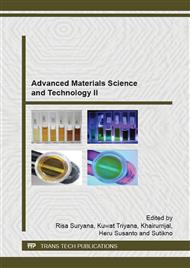[1]
J. Buongiorno, L.W. Hu, Nanofluids for enhanced economics and safety of nuclear reactors, MIT, Cambridge, (2007).
Google Scholar
[2]
M.S. Kang, C.Y. Jee, S.J. Park, L.C. Bang, G.Y. Heo, Design process of the nanofluid injection mechanism in nuclear power plants, Nanoscale Res. Lett. 2011, 6 (2011) 363.
DOI: 10.1186/1556-276x-6-363
Google Scholar
[3]
J. Buongiorno, L.W. Hu, Investigation of nanofluid for nuclear application, MIT, Cambridge, (2008).
Google Scholar
[4]
E. K. Goharashadi, H. Ahmazadeh, S. Samiee, W. Hadadian, Nanofluids for heat transfer enhancement-A Review, Phys. Chem. Res. 1 (1) (2009)1-33.
Google Scholar
[5]
M.M. Sarafraz, F. Hormozi, Forced convective and nucleate flow boiling heat transfer to alumina nanofluids, Chem. Eng. 58(1)(2014)37-46.
DOI: 10.3311/ppch.2206
Google Scholar
[6]
D. Zhu, X.F. Li, N. Wang, X. Wang, J. Gao, H. Li, Dispersion behavior and thermal conductivity characteristics of Al2O3–H2O nanofluids, Current App. Phys. 9 (2009) 131–139.
DOI: 10.1016/j.cap.2007.12.008
Google Scholar
[7]
S.J. Kim, I.C. Bang, J. Buongiorno, L.W. Hu, Study of pool boiling and critical heat flux enhancement in nanofluids, Bull. Polish Acad. Sci. Tech. Sci. 55 (2), (2007), 211-216.
Google Scholar
[8]
Y.L. Ding, H.S. Chen, L. Wang, C.Y. Yang, Y. He, W. Yang, W.P. Lee, L.L. Zhang, R. Huo, Heat transfer intensification using nanofluids, KONA 25 (2007) 23-36.
DOI: 10.14356/kona.2007006
Google Scholar
[9]
L.G. Asirvatham, N. Vishal, S.K. Gangatharan, D.M. La, Experimental study on forced convective heat transfers with low volume fraction of CuO/water nanofluid, Energies 2 (2009) 97-119.
DOI: 10.3390/en20100097
Google Scholar
[10]
S. Torii, Turbulent heat transfer behavior of nanofluid in a circular tube heated under constant heat flux, Adv. Mech. Eng. 2010 (2010)1-7.
DOI: 10.1155/2010/917612
Google Scholar
[11]
W. Yu, H. Xie, A Review on Nanofluids: Preparation, Stability Mechanisms, and Applications, Hindawi Publishing Corporation, J. Nanomater. 2012 (2012)1-17.
Google Scholar
[12]
Anonymous, Neutron scattering length and cross sections, Available on http: /www. ncnr. nist. gov/resources/n-lengths/, accessed on July 12, (2014).
Google Scholar
[13]
D.G. Syarif, Characteristics of water-ZrO2 nanofluids with different pH utilizing local ZrO2 nanoparticle prepared by precipitation method, Adv. Mater. Res. 896 (2014) 163-167.
DOI: 10.4028/www.scientific.net/amr.896.163
Google Scholar
[14]
M.R. Karim, M.A. Rahman, M.A.J. Miah, H. Ahmad, M. Yanagisawa and M. Ito, Synthesis of gamma-alumina particles and surface characterization, Open Coll. Sci. J. 4 (2011) 32-36.
Google Scholar
[15]
R.A. Bhogare, B.S. Kothawale, A review on applications and challenges of nanofluids as coolant in automobile radiator, Inter. J. Sci. Res. Pub. 3(8) (2013)1-11.
Google Scholar
[16]
X.J. Wang, X.F. Li, Influence of pH on nanofluids' viscosity and thermal conductivity, Chinese Phys. Lett. 26(5) (2009) 056601-1/4.
DOI: 10.1088/0256-307x/26/5/056601
Google Scholar


